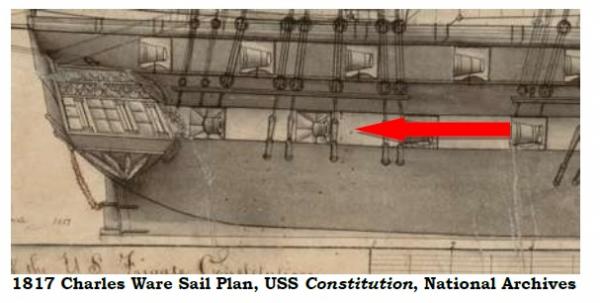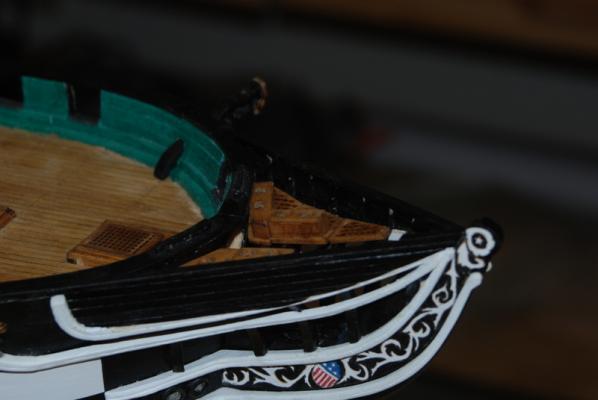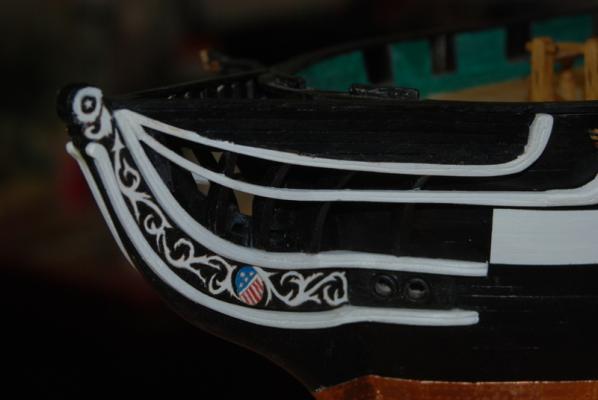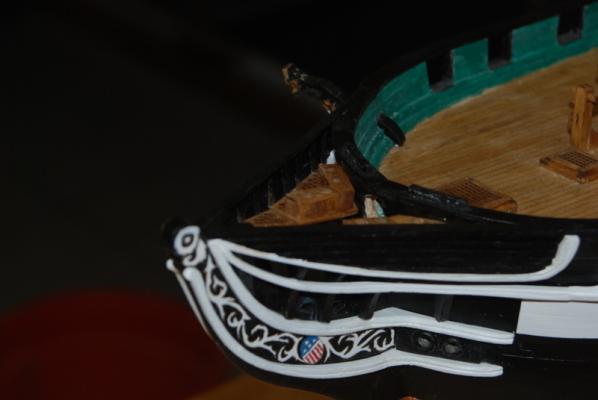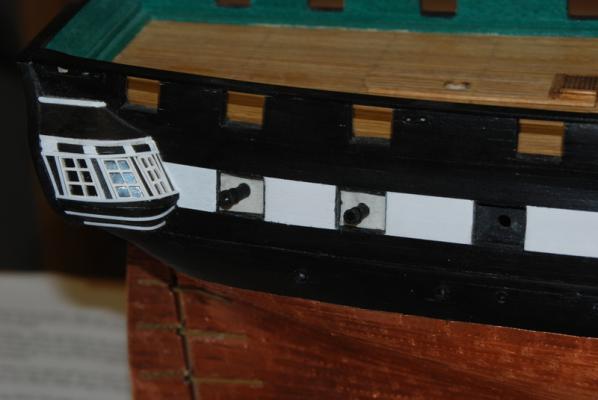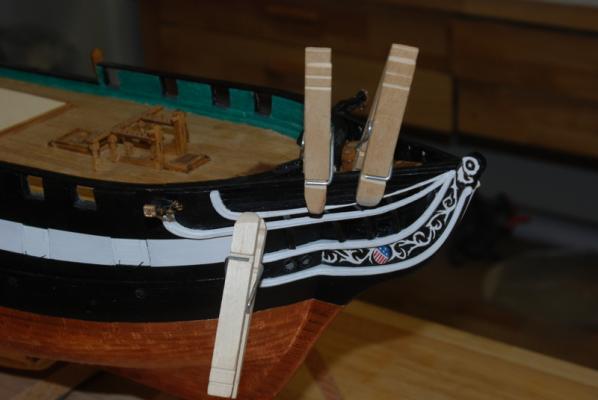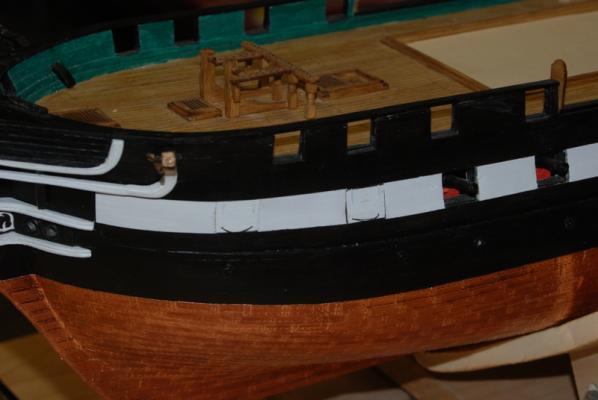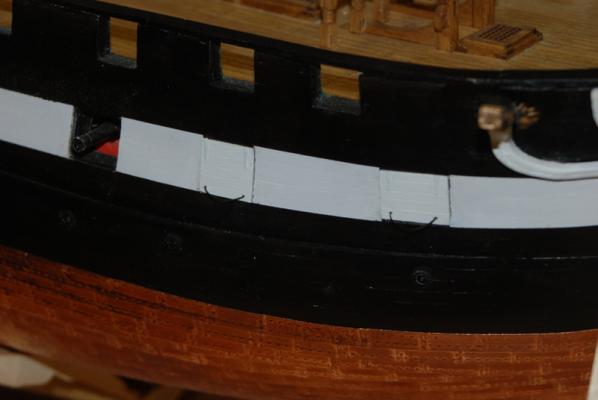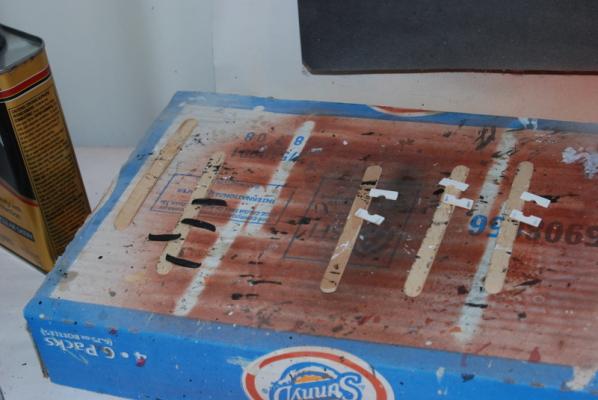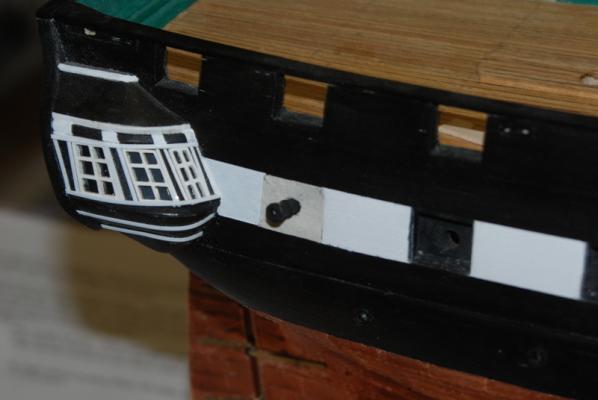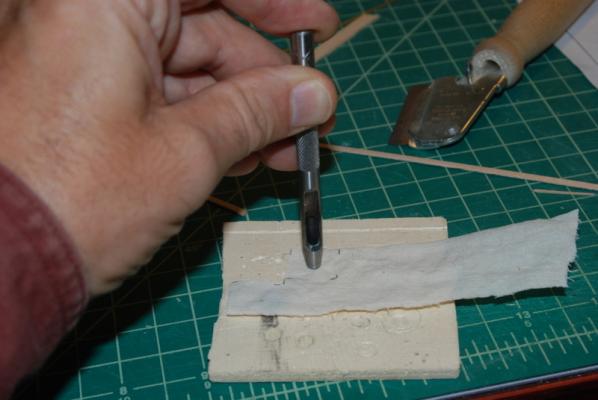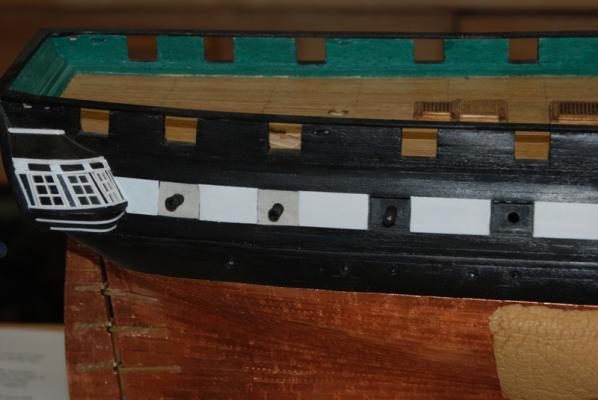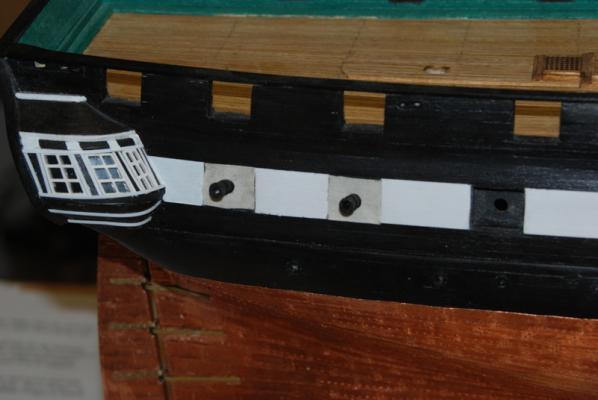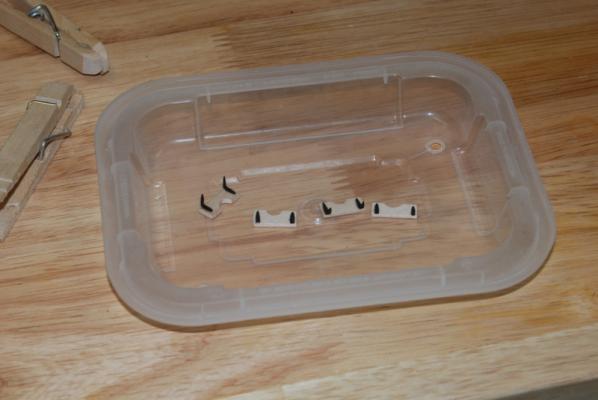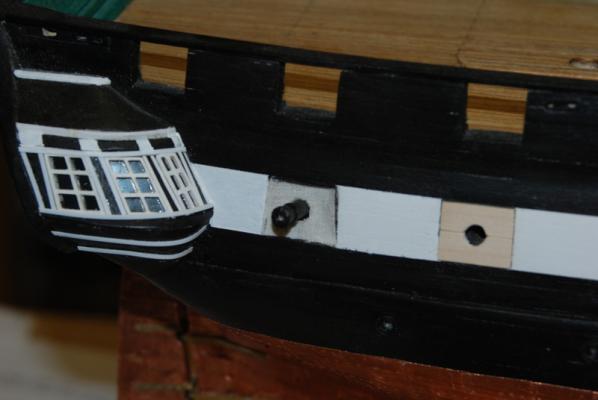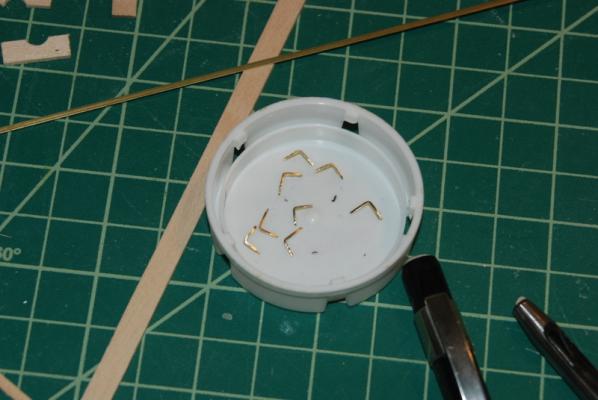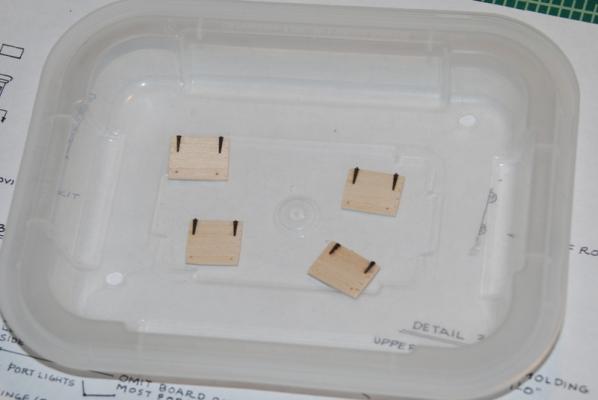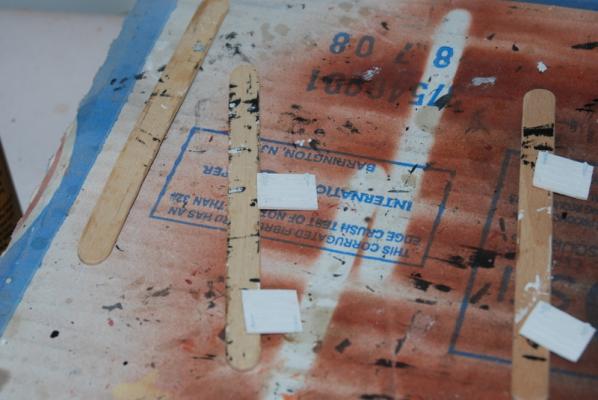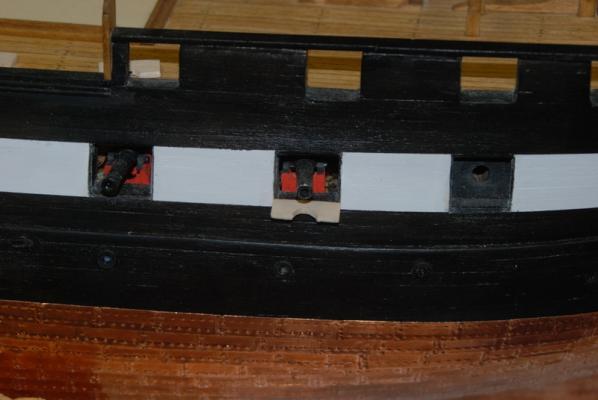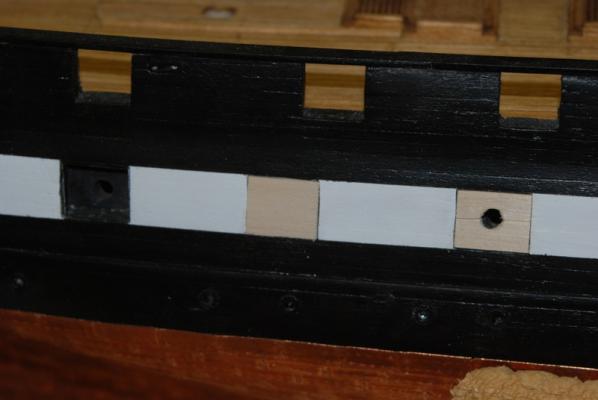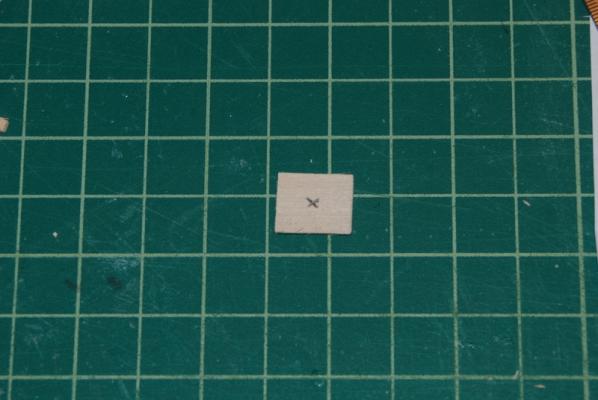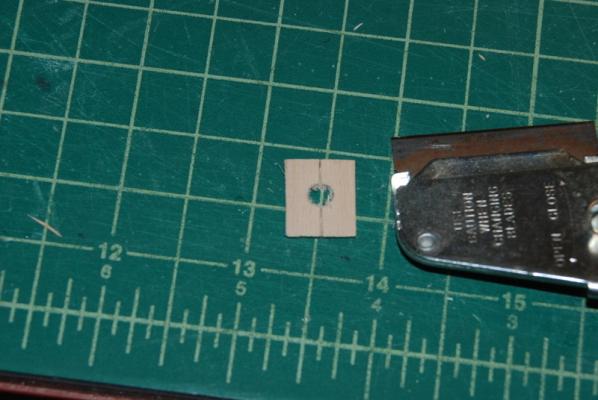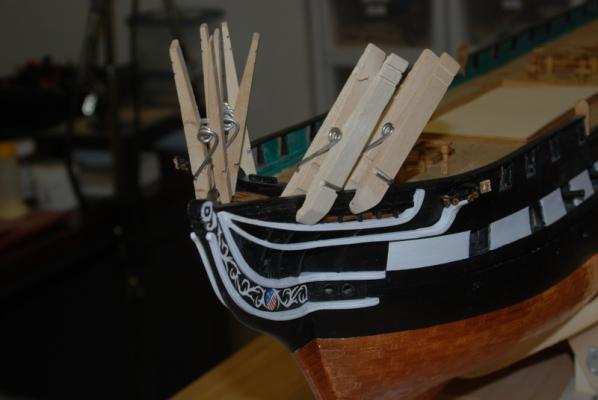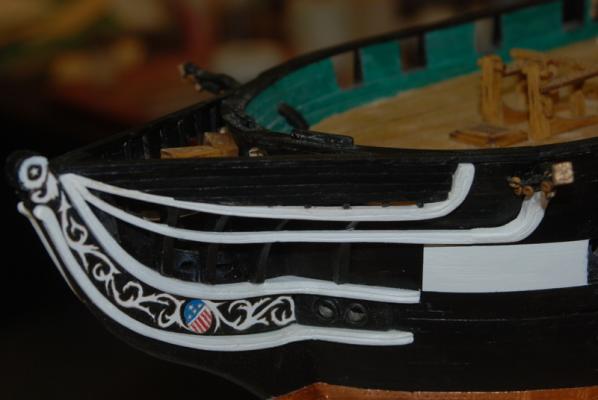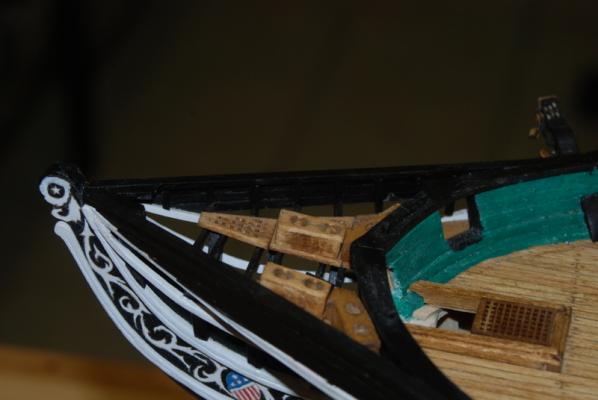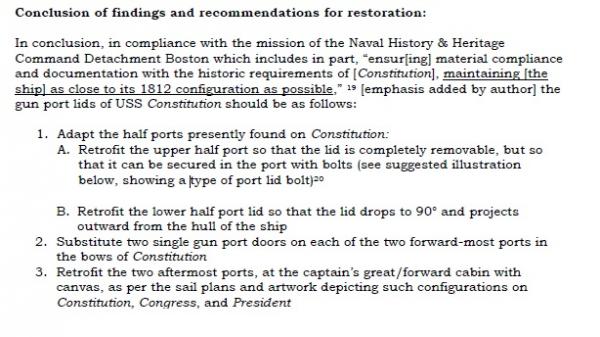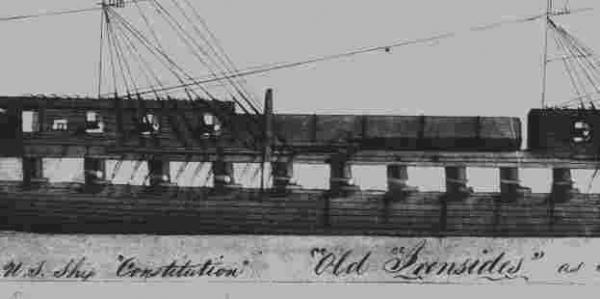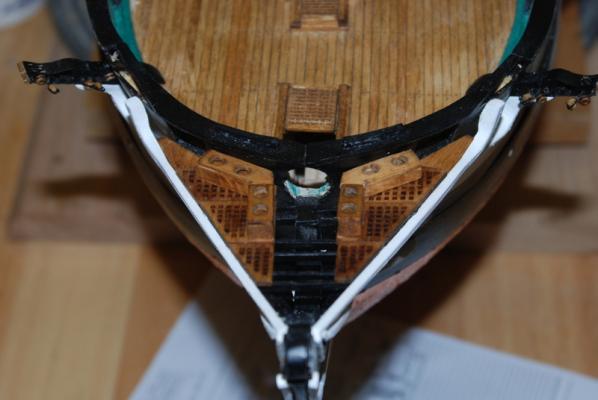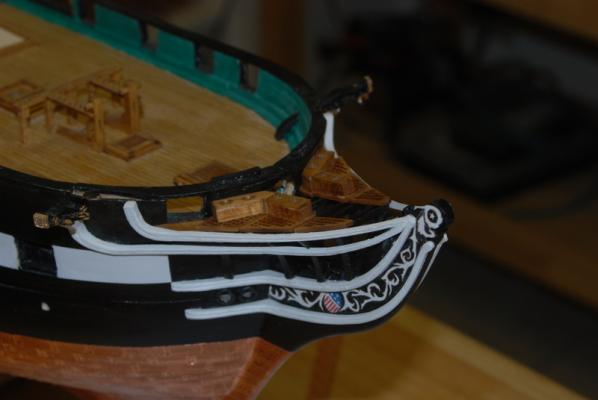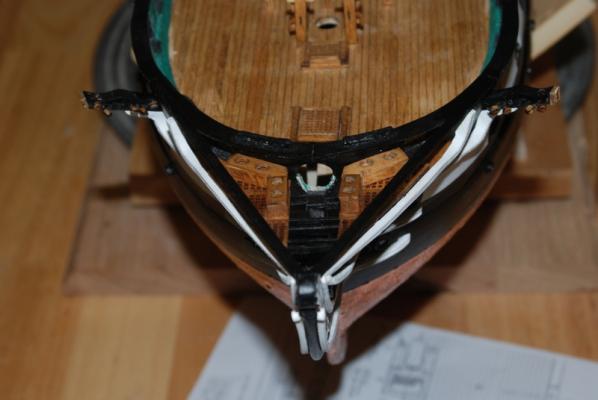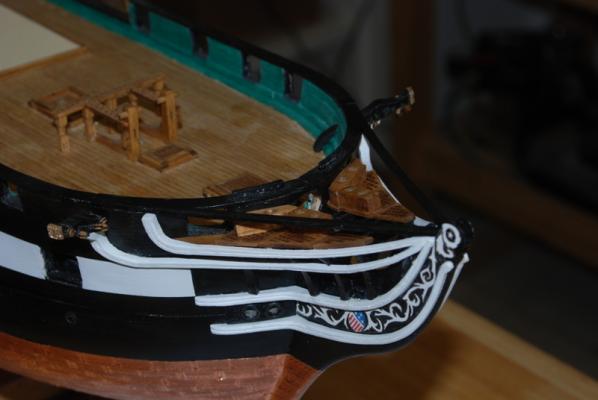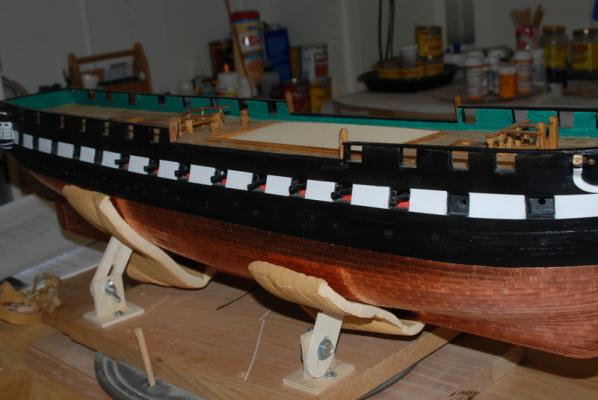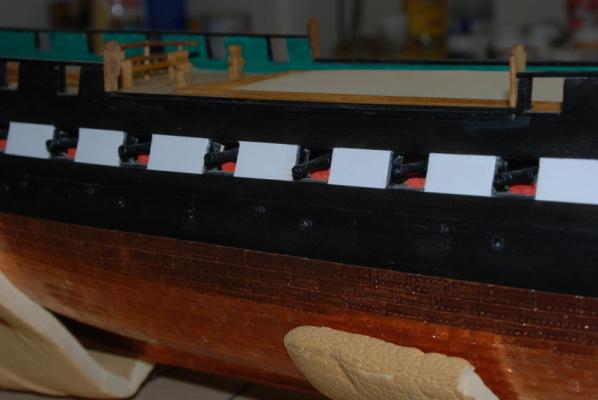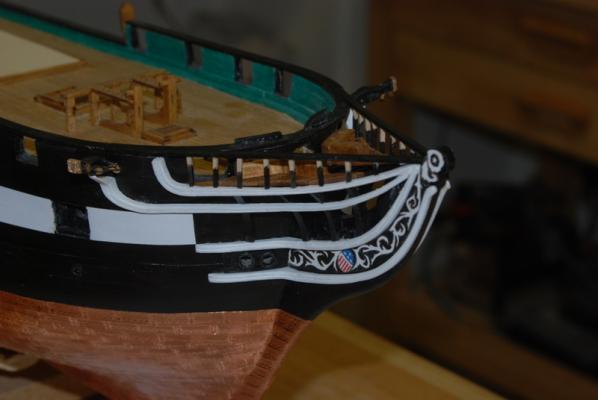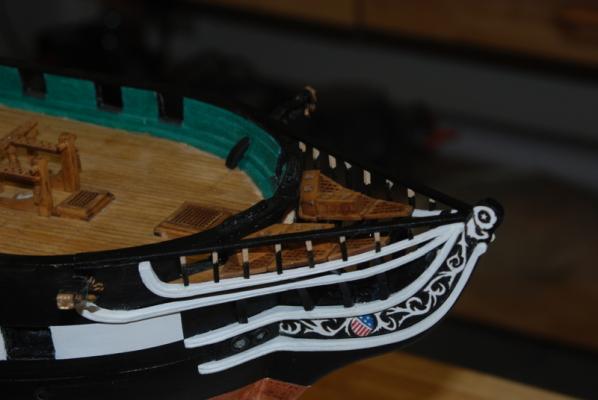-
Posts
2,407 -
Joined
-
Last visited
Content Type
Profiles
Forums
Gallery
Events
Everything posted by usedtosail
-
Thank you Dan for the details on the flag. I like that method a lot and will be trying it in the future.
- 108 replies
-
- andrea doria
- ocean liner
-
(and 1 more)
Tagged with:
-
Ken and Dan , thank you for the encouragement. It means a lot to me. Ken, I'll have to look for the Admiral's iron to try that. It doesn't get used much these days. Dan, here is one of the pictures I have been working off for the canvas covers. You can see a hole in the center with the gun sticking out. The others show the same thing. In the text it says this: The canvas covers in the captain’s great/forward cabin gun ports would have kept out some water when sailing in general or light weather, but more important, would have allowed diffused light to enter the cabin during all daylight hours, no matter the weather. If the weather was really inclement, likely half ports could have been fitted into the ports to secure them from heavy seas. No mention if they could be rolled down, but with the gun there it might have been difficult. These guns may have been stowed inside, but I am depicting this just before battle with some of the guns run out so I am thinking they would maybe in this position.
- 1,350 replies
-
- constitution
- model shipways
-
(and 1 more)
Tagged with:
-
Congratulations Dan. This was a great build to follow along. You should be very proud and your client should be very happy. I am a bit curious about how you made the flags. Could you elaborate on how you skewed the flag image, please. Also, it sounds like you printed directly to the silkspan. Did you use an ink jet printer for that? Thanks.
- 108 replies
-
- andrea doria
- ocean liner
-
(and 1 more)
Tagged with:
-
Greg, my first thought was to make a frame inside the rabbet, but the frame stuck out too much from the side with the cloth behind them. I would need a deeper rabbet around the gun ports. I didn't think about a frame inside the gun port, though. I may try that. Thanks.
- 1,350 replies
-
- constitution
- model shipways
-
(and 1 more)
Tagged with:
-
I touched up the paint around the head rails and planks and here is how it came out. I am pretty happy with the look. What I was not happy about was the look of those canvas gun port covers, especially the way the edges showed. I tried a few things and came up with a solution that I like a lot. I pushed them into the gun ports, and they look as if they were fastened on the inside of the ports, which they may have been. Here is how they came out: One small issue is that they are not glued in, only pressed in. The sail cloth with glue is pretty stiff so they have a spring to them that is holding them in place. I would hate to pull them out and try to get them back in place with some glue on the edges, but I may do that in the future. For now I am going to leave them as is. As always, any suggestions are most welcome.
- 1,350 replies
-
- constitution
- model shipways
-
(and 1 more)
Tagged with:
-
I am almost done with the head area. I glued the last plank in place just above the middle rail. I have a little clean up to do around the middle rails on both sides, then this area is done. Work on all the various gun port lid configurations continues. I glued in the full port lids on the first two gun ports on each side. I added half the line to open them by threading the line into two holes at the bottom of the lids and tying knots behind the holes. I will add the second line when I add the eye brows over these gun ports. The supplied eye brows have holes in them for the line into the hull, so I am going to thread the line through the hole, glue it to the back of the eye brow, glue the eye brow on, then tie the line to the line on the lids. Speaking of eye brows, I cleaned up four of them to go over these port, primed them and am painting them black. I am also painting the three starboard lids that will be closed around the dummy barrels white, after adding the hinges to the bottoms. I blackened the hinge/brackets I made for the open half lids and glued them on, then painted the lids white. I want to try these out on the hull before I make all of them. I have to really thank Ken for the suggestion to use 50/50 white glue on the sail cloth. I painted a swatch and let it dry overnight on some wax paper, then cut out the covers for the two starboard ports. I used a hole punch to cut the center hole, just applying pressure and rotating it by hand. It cut a nice clean hole. I then applied medium CA glue to the dummy cannon barrels where they fit into the holes in the back of the gun ports, and white glue around the lip of the gun ports, and glued the barrels and cloth in at the same time. I am enjoying making all these different port lids, especially doing a them in stages like this.
- 1,350 replies
-
- constitution
- model shipways
-
(and 1 more)
Tagged with:
-
Thanks Ken, I will give that a try.
- 1,350 replies
-
- constitution
- model shipways
-
(and 1 more)
Tagged with:
-
For the open lower gun port lids, I decided to make some 90 degree brackets that look like the photoetched hinges. I used some 1/64" by 1/16" brass strip and filed the hinge shape in by hand, then thinned the width down to about 3/64" I have only made 8 of the 32 I will need, but it was a good start. I also experimented with some sail cloth I had left over from another build to try to simulate the canvas gun port covers at the stern ports. I used a hole punch to make the hole for the cannon barrel. I think with some fray check on the edges and maybe some paint they will do. What do you think?
- 1,350 replies
-
- constitution
- model shipways
-
(and 1 more)
Tagged with:
-
OK, I found the file that shows the curved fife rail. It is file 49805001_1.pdf on the set of files that I have. If that is not on the CD, I can send you the pdf file in a PM.
- 1,350 replies
-
- constitution
- model shipways
-
(and 1 more)
Tagged with:
-
Bill, you are correct as there seems to be different versions of the CD. I actually downloaded the files from the web site before they were taken down, so I don't really know what is on the CD or what versions are out there. I also renamed all the files to make them easier for me to find stuff. I will go back and find the file that shows the curved fife rail and you can see if you have it. From now on I will stop referring to the files I have as from the CD, because my assumption that the files I have were all on the CD looks to be incorrect.
- 1,350 replies
-
- constitution
- model shipways
-
(and 1 more)
Tagged with:
-
You are a true Renaissance man, Michael. Those water colors are beautiful.
- 2,215 replies
-
Sorry, JS, that pdf is on the Constitution CD. The files on the CD used to be available from the web site, but the Navy took them down. Send me a PM with your email and I'll send it to you. I could not find an image of the full picture, but that piece came from the pdf document.
- 1,350 replies
-
- constitution
- model shipways
-
(and 1 more)
Tagged with:
-
As promised, here is the progress on the gun port lids. I started with the four full size lids for the front two ports on each side. I first had to thin down some sheet stock to the 3/64" width from 1/16". I used the Byrnes thickness sander for the first time and it worked great for this. I cut out pieces to fit snugly in each gun port, then used the back of an X-Acto blade to score plank lines into them to match the hull planking. I drilled holes in the bottom for the pull lines and glued etched hinges to the front. I am in the process of painting these white. For the half lids under the full cannon ports, I cut a strip of the thinned sheet that was the height of the half lid, then cut individual pieces from this for each gun port (starboard side only for now). I stacked these together and clamped them in my vise, then used a round file to make the round notches in them, all at the same time. I sanded these for the final fit. The only problem with this picture is that I have the lid inside the recess around the gun port. I think that these would really hinge so that they were below the recess when open, otherwise there would be nothing to stop them from opening all the way. This means I need to have some sort of physical support for these, like pins into the hull, but they are very thin so drilling holes for pins could be a problem. I think I might be able to make static hinges for these that will act like shelf supports and hold them in place, providing some support for them. I need to do some experimentation for these. For the closed half lids which will be around the dummy cannon barrels, I first thought I could use two half lids, but they did not meet up well in the center. So, I started with a single piece that fit into the gun port opening, like the full size lids. Once I had a good fit, I marked the center by connecting diagonal lines from the corners, then used the drill press to drill out a hole that the canon barrel will fit through. I then used the razor knife (with apparently a very rusty blade!) to split that piece in half, cutting with the grain of the wood to get a nice even line. I then fit both pieces in place, and they are ready for the hinges to be added. Lots of work left to do on these but a I am happy with the start I have made.
- 1,350 replies
-
- constitution
- model shipways
-
(and 1 more)
Tagged with:
-
Thank you George. I hope this build will be as useful to future Conny builders as those logs that I have been using are to me. Thanks for the likes too. It is exactly 2 years since I started this log, and I probably have another year to go at least. With my current job situation I will either end up with a lot more time for modeling or I may be starting a new job right away, which will cut into the modeling time I have now. Financially I am hoping for the latter but deep inside I would rather spend more time modeling. I can't tell the Admiral that though. I am still working the planks along the head area. I was able to add a few to each side, but now I have to do each one separately since I have to have the previous one glued in to fit the next one. I started at the top rail and am working my way down to the middle rail. I did paint the rest of the plank supports inside the planks after I glued in the first batch, so now it is just getting those last planks cut, fit, painted and glued in. In between planks, I have started making the gun port lids for the gun deck guns. I am going with the latest developments from the Constitution research team on how they think the gun port lids looked in the past. Here is the conclusions I am building too (mostly). From Gun Port Lids/Half Ports, a pdf on the Constitution web site, Researched and written by M.M. Desy, Historian Naval History & Heritage Command Detachment Boston February, 2013: Here is the painting they used to justify the 90 degree lower lids: The first two gun ports have dummy cannon barrels in them on my model, so I am going to just make full size port lids and have them closed, with hinges on the top and lines to open them going into the hull above them. No dummy barrels will be needed in those ports. For the next gun ports that have full cannons in them, I am making half lids for the bottoms, which I will show open at 90 degrees from the hull. They will have hinges on the bottoms, but no lines to open them, as the crew could just reach out to open and close them. I will not show any of the upper lids, as these would be stowed inside with the guns run out. All the remaining gun ports, which are to the rear of the ones with full cannons, have dummy cannon barrels in them. I will make both upper and lower port lids for these and show them with the dummy barrels sticking out through the hole. I will show hinges on only the bottom half, as the top half would not have them. I am not going to try to make canvas looking fillers in the last two gun ports, though, although I may change my mind on that point. I am not sure how I could make them look realistic, so I am going to make closed ports for now but try my hand at making canvas covers before using them. More on how I am making these lids in the next post. Finally, I want to wish you all a belated Happy New Year. For me, this is going to be an interesting year.
- 1,350 replies
-
- constitution
- model shipways
-
(and 1 more)
Tagged with:
-
Looks great Bob. All those lines at the bottom of the sail do look challenging!
- 196 replies
-
- higaki kaisen
- woody joe
-
(and 1 more)
Tagged with:
-
Congratulations Tom on a beautiful model. The only cure is to fire up another one at this point.
- 212 replies
-
- constellation
- artesania latina
-
(and 2 more)
Tagged with:
-
Thanks Tim. Despite your current setback with the Essex I am really enjoying following your progress.
- 1,350 replies
-
- constitution
- model shipways
-
(and 1 more)
Tagged with:
-
Both kids were home for the holidays but I did have a little time in the shop too. I cleaned up the head gratings and made the seats of ease. I finished these in oak stain and glued them in place, along with the solid pieces that flank the openings to the head. I made the two top rail pieces, painted them black and glued them to the openings left in the bow rail. While waiting for the paint to dry, I finally filled the holes in the sides of the hull. I drilled out the holes for the air ports and scuppers and glued them in place, then touched up the black paint on them. I made the supports for the planking between the top rail and the middle rail. I painted the bottom half of these black so I don't have to paint up to the white rail, and will paint the rest of them after I plank over them.
- 1,350 replies
-
- constitution
- model shipways
-
(and 1 more)
Tagged with:
-
There is still a lot of controversy on whether the Conny had 5 or 6 windows in 1812, which is the year I am building towards. I did exactly what George said to add 5 windows - moved the four transom pieces to fit between the window frames. I also did not add the spar deck chase ports as the notes I have said they weren't cut in until 1813. But it really comes down to what year your are going for and what other changes you want to make to conform to that configuration of the Conny. If you are building to today's configuration, I would keep the 3 windows as in the kit. If you are building to an older version you have to look at what other changes have been made since then.
About us
Modelshipworld - Advancing Ship Modeling through Research
SSL Secured
Your security is important for us so this Website is SSL-Secured
NRG Mailing Address
Nautical Research Guild
237 South Lincoln Street
Westmont IL, 60559-1917
Model Ship World ® and the MSW logo are Registered Trademarks, and belong to the Nautical Research Guild (United States Patent and Trademark Office: No. 6,929,264 & No. 6,929,274, registered Dec. 20, 2022)
Helpful Links
About the NRG
If you enjoy building ship models that are historically accurate as well as beautiful, then The Nautical Research Guild (NRG) is just right for you.
The Guild is a non-profit educational organization whose mission is to “Advance Ship Modeling Through Research”. We provide support to our members in their efforts to raise the quality of their model ships.
The Nautical Research Guild has published our world-renowned quarterly magazine, The Nautical Research Journal, since 1955. The pages of the Journal are full of articles by accomplished ship modelers who show you how they create those exquisite details on their models, and by maritime historians who show you the correct details to build. The Journal is available in both print and digital editions. Go to the NRG web site (www.thenrg.org) to download a complimentary digital copy of the Journal. The NRG also publishes plan sets, books and compilations of back issues of the Journal and the former Ships in Scale and Model Ship Builder magazines.




